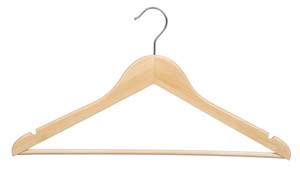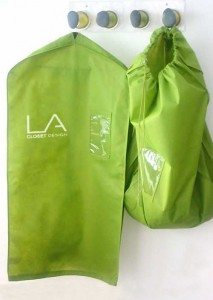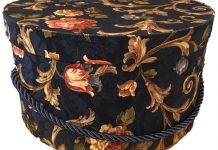
By Lisa Adams, Designer and CEO of LA Closet Design and LuxEco Advocate
Maximizing a closet is the number one issue for most people, and the underlying problems are universal: they are cluttered, overstuffed and lack organization. When your closet gets cramped, your lifestyle also suffers. You might find that you are perpetually running late, misplacing items that you need to leave the house in the morning, damaging your clothing, and losing time on things that matter.
Designing an organizing plan is the first and most important action step. I would also recommend critically dissecting the contents going into your closet. What are their health effects? Are they made out of eco-friendly materials? Below are some helpful tips and “green” product picks that can help start you off on the right track:
- Start by removing everything from your existing closet. Then evaluate and audit every piece of your closet. Purge, recycle or donate any item you have not worn in the last six months (aside from seasonal items).
- Determine in what grouping you would like your clothes to be organized and then start separating them into piles. (e.g. type, color, length, purpose, etc).
- Wipe down and clean your shelves and rods with non-petroleum based, natural cleaners. Tip: Try mixing water and baking soda into a spray bottle – instant eco-fix!
- Invest in hangers! Plastic hangers or wire hangers from the cleaners are damaging to you, your clothing and the
 environment. Use bamboo hangers as an eco-friendly alternative. Bamboo is a wonderful replacement plant for trees given its short growth cycle and high carbon dioxide exchange rate; after all, it is a grass and grows very quickly. Where oak takes 120 years to grow to maturity, bamboo can be harvested in three years. It is recognized as a green material under LEED.
environment. Use bamboo hangers as an eco-friendly alternative. Bamboo is a wonderful replacement plant for trees given its short growth cycle and high carbon dioxide exchange rate; after all, it is a grass and grows very quickly. Where oak takes 120 years to grow to maturity, bamboo can be harvested in three years. It is recognized as a green material under LEED.
- Do laundry and dry cleaning the eco-friendly way. When doing laundry at home, use green friendly detergents and fabric softeners. With dry cleaning, do some research on the eco-friendly dry cleaners in your area, and make sure they are NCA Green certified. Do away with toxic plastic dry cleaning bags, and instead use these 3-in-1 convertible, reusable bags, which convert from a dry cleaning bag to a duffle bag and into a garment bag. You take your dry cleaning to your cleaners in a duffle bag, and they return your items to you in a garment bag—wallah!
- If you have a moth problem, consider FSC (Forest Stewardship Council) Certified cedar balls or Lavender Drawer Liners. They both give off a clean, fresh and relaxing scent offensive to moths and other harmful insects. Both are all-natural and have none of the harmful side effects of chemical poison alternatives.
- Using existing shoe boxes as storage boxes are an easy and eco-way of maintaining hard to organize items. These fabulous eco-fabric open bins are alternative options.
- Once you have your clothing sorted in piles and accessories accounted for, start putting each piece back where it belongs in your new and improved closet. After you have organized each item into the closet, everything should now have a resting place. Start getting into the routine of organizing your closet on an ongoing basis and stick with it!














